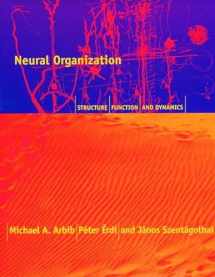
Neural Organization: Structure, Function, and Dynamics (Bradford Book)
ISBN-13:
9780262526418
ISBN-10:
0262526417
Author:
Michael A. Arbib, Peter Erdi, Alice Szentagothai
Publication date:
1997
Publisher:
MIT Press
Format:
Paperback
420 pages
FREE US shipping
Book details
ISBN-13:
9780262526418
ISBN-10:
0262526417
Author:
Michael A. Arbib, Peter Erdi, Alice Szentagothai
Publication date:
1997
Publisher:
MIT Press
Format:
Paperback
420 pages
Summary
Neural Organization: Structure, Function, and Dynamics (Bradford Book) (ISBN-13: 9780262526418 and ISBN-10: 0262526417), written by authors
Michael A. Arbib, Peter Erdi, Alice Szentagothai, was published by MIT Press in 1997.
With an overall rating of 4.3 stars, it's a notable title among other
books. You can easily purchase or rent Neural Organization: Structure, Function, and Dynamics (Bradford Book) (Paperback) from BooksRun,
along with many other new and used
books
and textbooks.
And, if you're looking to sell your copy, our current buyback offer is $0.3.
Description
In Neural Organization, Arbib, Érdi, and Szentágothai integrate structural, functional, and dynamical approaches to the interaction of brain models and neurobiologcal experiments.In Neural Organization, Arbib, Érdi, and Szentágothai integrate structural, functional, and dynamical approaches to the interaction of brain models and neurobiologcal experiments. Both structure-based "bottom-up" and function- based "top-down" models offer coherent concepts by which to evaluate the experimental data. The goal of this book is to point out the advantages of a multidisciplinary, multistrategied approach to the brain.Part I of Neural Organization provides a detailed introduction to each of the three areas of structure, function, and dynamics. Structure refers to the anatomical aspects of the brain and the relations between different brain regions. Function refers to skills and behaviors, which are explained by means of functional schemas and biologically based neural networks. Dynamics refers to the use of a mathematical framework to analyze the temporal change of neural activities and synaptic connectivities that underlie brain development and plasticity--in terms of both detailed single-cell models and large-scale network models.In part II, the authors show how their systematic approach can be used to analyze specific parts of the nervous system--the olfactory system, hippocampus, thalamus, cerebral cortex, cerebellum, and basal ganglia--as well as to integrate data from the study of brain regions, functional models, and the dynamics of neural networks. In conclusion, they offer a plan for the use of their methods in the development of cognitive neuroscience.


We would LOVE it if you could help us and other readers by reviewing the book
Book review

Congratulations! We have received your book review.
{user}
{createdAt}
by {truncated_author}


